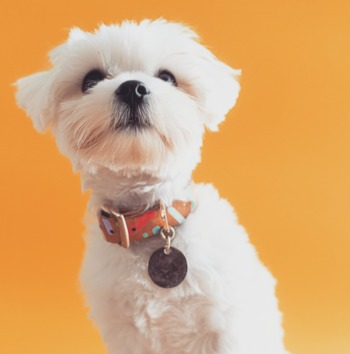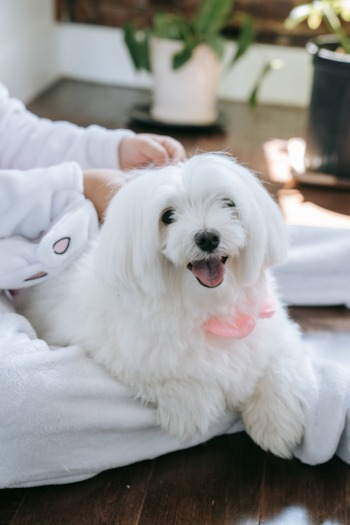Maltese Breed Information


The Maltese breed, renowned for its charming and affectionate nature, is a small, elegant toy dog that has captured the hearts of dog lovers worldwide. With a striking, silky white coat and an endearing, gentle temperament, this breed has become a popular choice for individuals and families looking for a loving companion.
Originating from the island of Malta in the Mediterranean, the Maltese has a rich history dating back thousands of years. Ancient civilizations, including the Greeks and Romans, cherished these dogs for their beauty and grace, often featuring them in their artwork and writings. The breed's captivating appearance and delightful personality have led to its continued popularity, with many celebrities and historical figures, such as Queen Elizabeth I and Marilyn Monroe, owning Maltese dogs.
One of the most appealing aspects of the Maltese breed is its low-shedding, hypoallergenic coat, which makes it an excellent choice for people with allergies. The long, silky hair requires regular grooming to keep it tangle-free and looking its best. However, many owners choose to keep their Maltese in a short "puppy cut" for easier maintenance.
Characteristics
- Affectionate and loyal: The Maltese breed is known for its loving and devoted nature, forming strong bonds with its family members and thriving on human companionship.
- Elegant and graceful: With their luxurious, silky white coat, expressive eyes, and poised demeanor, Maltese dogs exude an air of refinement and elegance, making them a popular choice for dog enthusiasts.
- Adaptable and versatile: The Maltese breed is highly adaptable, able to adjust to various living situations, from bustling city apartments to tranquil suburban homes, making them suitable for a wide range of lifestyles.
- Playful and energetic: Despite their small size, Maltese dogs possess a lively and spirited personality, enjoying activities such as daily walks, interactive games, and even dog sports like agility and rally.
- Intelligent and trainable: The Maltese breed is known for its intelligence and eagerness to please, making them highly trainable and capable of learning various commands and tricks.
- Hypoallergenic and low-shedding: The Maltese breed's silky, straight hair is low-shedding and hypoallergenic, making them an excellent choice for those with allergies or sensitivities to pet dander.
- Long-lived and hardy: With proper care, a balanced diet, regular exercise, and routine veterinary checkups, the Maltese breed can enjoy a relatively long lifespan of 12 to 15 years or even longer, providing many years of love and companionship.

Appearance
The Maltese breed's appearance is undeniably captivating, characterized by its small size, graceful elegance, and stunning, silky white coat. Weighing between 4 to 7 pounds and standing at 8 to 10 inches tall, this toy breed is the perfect size for a lap dog, making it an ideal companion for those seeking a petite and affectionate pet.
One of the most striking features of the Maltese breed is its luxurious, floor-length coat. The silky, straight hair is pure white, sometimes displaying a slight ivory or pale cream hue. This beautiful coat is low-shedding and hypoallergenic, making the breed an excellent choice for those with allergies. Regular grooming is necessary to maintain the coat's health and prevent matting. Many owners opt for a shorter "puppy cut" to simplify coat care and provide their Maltese with a more manageable hairstyle.
The Maltese breed's face is equally endearing, featuring dark, round eyes that exude warmth and expressiveness. Their button nose is black, providing a striking contrast against their white fur. The breed's ears are drop-shaped and covered in feathered hair, blending seamlessly with the rest of the coat.
The Maltese's body is compact and well-proportioned, with a level topline and a slightly rounded chest. Their plumed tail is another distinctive feature, gracefully curving over their back and adorned with long, flowing hair. The breed's overall appearance exudes a sense of refinement and poise, making them a popular choice for dog shows and competitions.
Temperament
The Maltese breed is renowned for its affectionate, gentle, and friendly temperament, making it a delightful companion for individuals and families alike. This loving and sociable breed thrives on human interaction and bonds deeply with its family members, often displaying a strong sense of loyalty and devotion.
Although small in size, Maltese dogs possess a lively and spirited nature. They are known for their playful and energetic personalities, enjoying activities such as daily walks and interactive games. The breed's intelligence and eagerness to please make them highly trainable, and they excel in obedience training and various dog sports, such as agility and rally.
Despite their playful disposition, Maltese dogs are also known for their adaptable and easygoing nature. They are content to spend time cuddling on the couch or participating in more low-key activities, making them suitable for various living situations, from bustling city apartments to serene suburban homes.
While the Maltese breed is typically friendly towards other pets and children, their small size makes them vulnerable to unintentional injury. Therefore, it is essential to supervise interactions with young children and larger pets to ensure their safety.
One aspect to consider with the Maltese temperament is that they may be prone to separation anxiety due to their strong attachment to their owners. Proper training and socialization from an early age can help mitigate this issue, ensuring that your Maltese feels secure and comfortable even when left alone for short periods.
Care
Grooming
The Maltese breed's stunning, silky white coat, although beautiful, does require consistent grooming to keep it in optimal condition. Regular grooming sessions not only maintain the coat's appearance but also promote the overall health and well-being of your Maltese companion.
One of the essential aspects of grooming a Maltese is brushing their coat daily to prevent tangles and matting. A pin brush or a slicker brush can be used to gently work through the hair, ensuring that all knots are removed. It's crucial to be gentle while brushing, as the breed's skin can be sensitive.
Bathing your Maltese approximately every three to four weeks is recommended to keep their coat clean and fresh. Using a mild, dog-specific shampoo will help preserve the natural oils in their skin and coat, preventing dryness and irritation. After bathing, it's essential to thoroughly dry their hair, as dampness can lead to skin issues.
To prevent tear staining around the eyes, it's important to clean the eye area daily with a soft, damp cloth or specialized eye wipes. Regularly trimming the hair around the eyes can also minimize the risk of eye irritation and improve visibility.
Maintaining good dental hygiene is vital for the Maltese breed, as they can be prone to dental issues. Brushing their teeth several times a week with dog-safe toothpaste will help prevent plaque buildup and keep their breath fresh. Regular dental checkups at the vet are also advised to ensure optimal oral health.
Nail trimming is another essential aspect of grooming. The Maltese's nails should be trimmed every three to four weeks to prevent overgrowth and discomfort. Additionally, regular ear cleaning can help prevent ear infections and maintain overall ear health.
For those who prefer a more manageable coat, many owners opt for the popular "puppy cut," which involves trimming the hair to a shorter, more uniform length. This low-maintenance style can be maintained with professional grooming appointments every six to eight weeks.
Exercise Needs
Despite their small stature, the Maltese breed possesses a lively and energetic disposition, requiring daily exercise to keep them happy and healthy. Although their exercise needs are relatively moderate compared to larger breeds, it's essential to provide your Maltese with regular physical and mental stimulation to maintain their overall well-being.
Daily walks are an excellent way to meet the exercise needs of a Maltese, with two short walks or one longer walk being sufficient to keep them satisfied. These walks not only provide physical exercise but also offer mental stimulation, as your Maltese explores new sights, sounds, and smells in their environment.
In addition to walks, Maltese dogs enjoy engaging in interactive play sessions, both indoors and outdoors. Games such as fetch, hide-and-seek, or agility exercises can keep your Maltese entertained while providing valuable bonding time between you and your pet. Interactive toys and puzzle feeders can also be beneficial in keeping your Maltese mentally engaged when you're not available to play.
It's essential to keep in mind that the Maltese breed's small size makes them susceptible to injury, especially during playtime or outdoor activities. Ensure that your Maltese is supervised during exercise and play and provide a safe environment to prevent any potential accidents or injuries.
Health
The Maltese breed, like all dogs, can be susceptible to certain health issues. However, with proper care, regular veterinary checkups, and a healthy lifestyle, these charming little dogs can enjoy a long and happy life, often living up to 12 to 15 years or even longer.
It's crucial for potential Maltese owners to be aware of common health concerns affecting the breed and take preventative measures to ensure their dog's well-being. Some health issues that may affect the Maltese breed include dental problems, ear infections, and skin or food allergies.
Lifespan
The Maltese breed is known for its relatively long lifespan, which is a testament to their overall hardiness and adaptability. With proper care, a balanced diet, regular exercise, and routine veterinary checkups, these delightful little dogs can enjoy a life expectancy ranging from 12 to 15 years, and in some cases, they may even live longer.
Several factors contribute to the Maltese breed's longevity, including their small size and generally robust health. However, it's essential for owners to take an active role in maintaining their dog's well-being to ensure they live a long and happy life. This includes providing a high-quality diet tailored to their specific nutritional needs, engaging in daily exercise, and meeting their grooming requirements to maintain a healthy coat and skin.
Regular veterinary checkups are vital for the early detection and treatment of any potential health issues that may arise during your Maltese's life. Preventative care, such as vaccinations, parasite control, and dental cleanings, can also contribute to your dog's overall health and longevity.
Genetics play a role in the Maltese breed's lifespan, so selecting a responsible breeder who follows ethical breeding practices and screens for hereditary conditions is crucial. A well-bred Maltese puppy will have a higher chance of enjoying a long and healthy life.
Training
The Maltese breed is known for its intelligence and eagerness to please, making them highly trainable and capable of learning various commands, tricks, and even excelling in dog sports. Training a Maltese can be a rewarding experience for both the owner and the dog, as it strengthens the bond between them and promotes a well-behaved, happy companion.
When training a Maltese, it's crucial to use positive reinforcement techniques, such as praise, treats, and toys, to encourage desired behaviors. This breed tends to be sensitive and can become discouraged by harsh training methods, so keeping sessions fun, engaging, and rewarding will yield the best results.
Socialization is an essential aspect of training for the Maltese breed. Exposing your Maltese to a variety of people, animals, and environments from an early age will help them develop into a well-adjusted, confident adult dog. Puppy socialization classes, dog-friendly parks, and neighborhood walks are great opportunities for your Maltese to experience new situations and interact with different stimuli.
House training can be a challenge for some Maltese puppies due to their small size and occasional stubbornness. Consistency, patience, and a regular schedule are key factors in successfully house training your Maltese. Crate training can also be beneficial, as it provides a safe, comfortable space for your dog and helps establish a routine.
The Maltese breed can be prone to separation anxiety due to their strong bond with their owners. Training your Maltese to feel secure and comfortable when left alone is essential in preventing this issue. Gradually increasing the time spent apart and providing interactive toys to keep them occupied can help alleviate separation anxiety.
Obedience training and dog sports, such as agility, rally, or even canine freestyle, can provide both physical and mental stimulation for your Maltese. These activities not only offer an outlet for their energy but also serve as a fun and engaging way to strengthen your bond with your dog.
History
The Maltese breed boasts an extensive and fascinating history that dates back over 2,000 years. This ancient toy breed, believed to have originated from the island of Malta, has captivated the hearts of dog lovers throughout the ages. The Maltese's presence can be traced back to the time of the ancient Greeks and Romans, who held the breed in high regard for its beauty and charm. Aristocrats and noble families often kept Maltese dogs as companions, even considering them a symbol of status and luxury.
Historical evidence, such as the famous Greek philosopher Aristotle's writings, mentions the Maltese breed, highlighting its small size and elegance. The breed's influence also spread to ancient Rome, where it was highly esteemed by prominent figures like Publius, a Roman governor who wrote about his beloved Maltese, named Issa.
Throughout the centuries, the Maltese breed has continued to enchant dog enthusiasts and has been featured in various artworks, including paintings and ceramics. As the breed spread across Europe, it gained popularity among royalty and aristocracy, with prominent figures such as Queen Elizabeth I and Mary Queen of Scots owning Maltese dogs.
In the 19th century, the Maltese breed made its way to the United States, quickly gaining popularity among dog lovers for its charming appearance and loving nature. The American Kennel Club (AKC) officially recognized the breed in 1888, further solidifying its presence in the world of purebred dogs.
Today, the Maltese breed enjoys a loyal following worldwide, with enthusiasts celebrating its rich history, elegant appearance, and loving temperament. The breed's historical significance and timeless appeal make it a cherished companion for many dog lovers, from royalty to everyday families.



